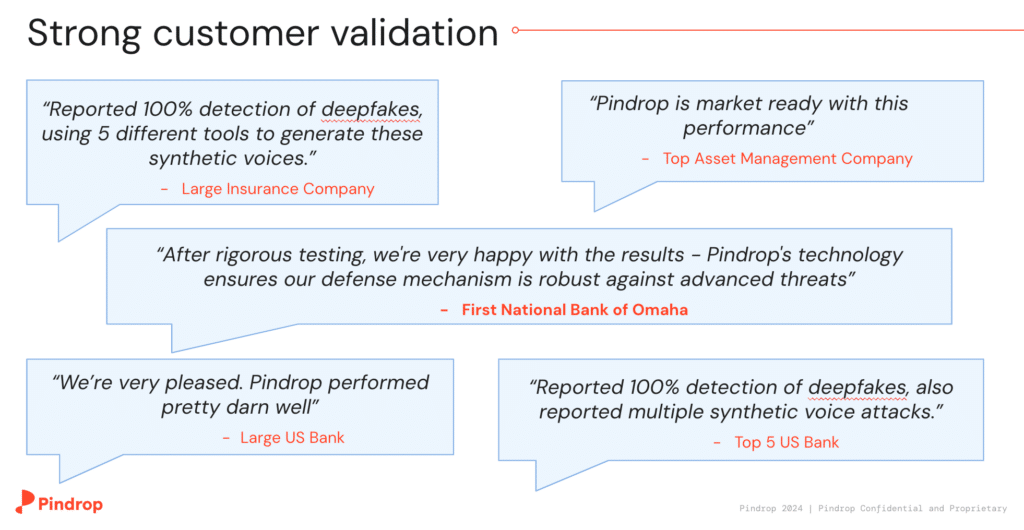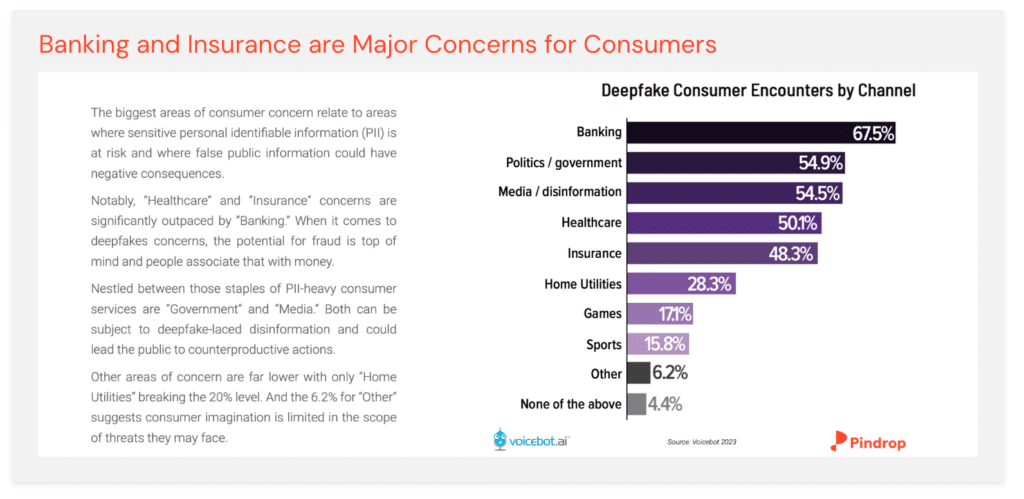Pindrop recently hosted a webinar on Voice Theft and How Audio Deepfakes Are Comprising Security on Tuesday, March 5th. Top C-suite execs from Pindrop shared their research and insights on how Pindrop Pulse is leading the battle against deepfakes with its latest technology.
As we’ve seen in the media recently, Generative AI continues to advance at an unprecedented pace. Pulse is an actionable product and solution designed to help you build customer trust as it detects deepfakes from infiltrating your business and workflows. Pulse is a new add-on module that is a fully integrated engine that works with Pindrop Protect and Pindrop Passport as a sophisticated deepfake detection solution.
Let’s explore the common mysteries surrounding deepfakes and the new technology discussed in the webinar. We’ll also discuss what your company can do to leverage technology to protect itself better.
What is a Deepfake?
Deepfake is a term that first emerged in 2017 and describes synthetic media that replaces one person’s likeness and voice with another using artificial intelligence (AI) technologies. What changed in 2023 was the emergence of generative AI and the ability for anyone to create deepfakes at minimal cost with public voice data.
How Does Liveness Detection Work?
Liveness detection identifies deepfake audio by detecting unique patterns that differ from speech, like frequency changes and spectral distortions. Pindrop’s technology uses AI to produce a “fakeprint” — a unit-vector low-rank mathematical representation preserving the artifacts that distinguish between machine-generated and genuine speech. The results, even with the largest banks, were astounding.
Here’s what top customers leveraging the product have said:

>>This article also details how Pulse analyzes emerging themes across various beta partners.
1) Clearing Up Why and How Deepfake Production Is on the Rise
Since deepfakes are on the rise across every industry and causing real threats to call center security, companies can rest easy with the right technology to detect and protect against them. In January, Pindrop released the Pulse liveness detection add-on module as a beta to customers, who discovered the patterns of deepfake attacks and how bad actors were adopting the technology to attack call centers.
>>When fraudsters can record a voice and create deepfakes within minutes, it becomes imperative to have technology to combat and protect IVRs against the risks.
2) Uncovering How Fraudsters Are Infiltrating Top Security Systems Using Deepfakes
The most significant areas of consumer concern relate to areas where sensitive personal identifiable information (PII) is at risk, and false public information could have negative consequences. Notably, most concerns tend to be in healthcare and insurance but need to be more balanced by banking, according to research done by Voicebot.ai and Pindrop. Government and media are also expressing concern and are subject to deepfake-laced misinformation.

Types of attacks Pindrop has caught firsthand include IVR Navigation, targeted account discovery, profile changes, and voice bots being trained to mimic the IVRs at banks. The webinar highlighted two recent research articles to break this down further:
- One around how testing your existing system might be able to help against deepfake vulnerabilities
- The second is Pindrop Pulse’s ability to identify patterns of deepfake attacks in call centers
The learnings noted in each article explain how most biometric authentication systems were neither designed nor operationalized to protect against the sophisticated deepfakes attacking call centers today and how paramount it can be to implement a solution that can keep out the bad actors using Gen AI.
3) A Multi-Pronged Approach Will Be Required to Catch Deepfakes in the Future
What became apparent during the webinar and in reading the articles mentioned was that companies will need to invest in multi-pronged analysis to protect against deepfakes in the future. Humans won’t be able to do it alone, and the technology is advancing quickly.
This entails examining metrics in specific scenarios or variable combinations, such as False Acceptance Rate (FAR) and Synthetic Voice Injection across different net speech intervals with more detailed analysis to increase the likelihood that fraud won’t get through a system’s sensitivity with robust fraud detection. Getting the right system to check all these variables also ensures you can preserve the customer experience.
CONCLUSION: How to Stop Deepfake Risks in the Future
As deepfake creation rises, it’s important to review and implement the best technology that combats risks to your business and customer experience. Pindrop Pulse is the only technology to safeguard your business against fraud and trust erosion caused by deepfakes.
Pindrop’s technology uses seven key features to detect deepfakes in their track:
- It’s comprehensive with liveness detection, so it can spot text-to-speech, voicebot, voice modulation, and voice conversion — detecting replay and modulated voices.
- It’s a proprietary AI model developed over eight years without relying on watermarking or specific voice-generated tools.
- It uses a unique dataset of over 20M unique audio utterances.
- It’s language and phrase agnostic.
- Pindrop is leading the industry with over 18 patents granted in deepfake and synthetic voice detection and over 130 in voice security.
- It’s academically benchmarked and validated ASV proof since 2017.
- It’s continually enhancing its technology to keep up with deepfake evolution.
Contact a rep today to schedule a demo and see how this new product works.



